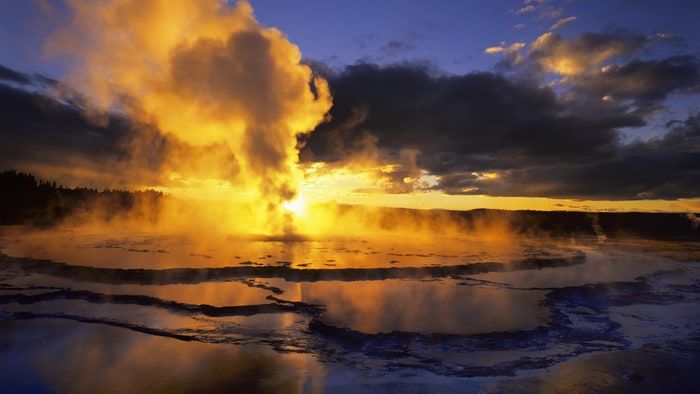The Complete Guide To Yellowstone National Park
Yellowstone doesn’t mean to brag, but its kaleidoscopic geothermal wonders, grand canyons, and high-altitude lakes have, without a doubt, made it the showpiece of the National Park System. Not only was this the first national park in the entire world, but to this day, it welcomes more than 4.1 million visitors who come to bask in the iconic terrain of the American West (think: grassy plains teeming with bison and pine-covered valley walls abuzz with grizzly bears).
“Yellowstone is home to the largest concentration of mammals in the Lower 48,” says ranger Amy Bartlett, who’s been visiting the park since she was three month’s old and working here since 1994. “It also has more than 10,000 hydrothermal features and more than 3,000 geysers,” making this 3,472-square-mile patch of land the address of roughly half of Earth’s geothermal marvels.
Consequently, Bartlett believes any visit to Yellowstone should start with a tour of the steaming Upper and Lower Geyser Basins. “If you time it right, you should be able to hit seven major geysers in one day,” she says. Those include the spotlight-hogging Old Faithful, but also even more spectacular fountains of gurgling earth-innards like Grand Geyser, the world’s tallest predictable geyser at a height of 200 feet.
RELATED: The Complete Guide to Zion National Park
Kayak to Shoshone Geyser Basin
You’ll find even more explosive wonders (and a fraction of the tourists) on a kayak journey from Lewis Lake to the park’s largest backcountry geyser basin along the shores of Shoshone Lake. Bartlett recommends three days and two nights to survey the area and its more than 500 geothermal features (including several regularly erupting geysers), with overnight stays in primitive lakeside campgrounds. Do it on your own or enlist the expertise of Geyser Kayak Tours, which offers two seasonal multiday options from $925/person.
Drop Down Into the Grand Canyon
Escape the crowds above and head into the bowels of the Grand Canyon of the Yellowstone on the Seven Mile Hole trail, which begins at the Glacial Boulder Trailhead near Canyon Village. “Most people only see the Grand Canyon from the rim, but this actually drops you down into it where you’ll get an amazing and completely different prospective,” says Bartlett, who loves this hike so much she did it on her honeymoon. Though just 11 miles round-trip, Bartlett recommends splitting the journey across two days and spending the night at one of three backcountry campsites along the Yellowstone River, as there’s an elevation gain and loss of about 1,700 feet. Look out for the geothermal area near the river’s edge with its bubbling pools and steaming vents.
RELATED: The Complete Guide to Zion National Park
Where to Stay
With well over 2,000 idyllic campsites to choose from, it’s hard to justify staying indoors, but the rustic log-and-stone-hewn Old Faithful Inn is an absolute wonder to behold, with an 85-foot fireplace, soaring ceilings, and creaky wooden floors at every step. If you can’t score a room at the Inn, try Lake Yellowstone Hotel, an old-school charmer that’s currently celebrating 125 years welcoming guests into the park. With string quartets playing in the lobby and a sunroom facing onto the lake, Bartlett says it “takes you back to the old days when women came to Yellowstone in petticoats.”
